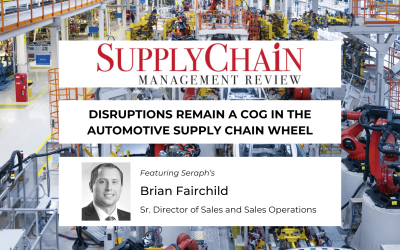This marks the first article covering Seraph’s 4-part MOVE methodology. Click here for the overview.
Relocation and consolidation activities are risky for you and your customers. A well thought out strategic alignment is the first step to prepare for the best possible outcome.
Considering the precipitous drop in demand as a result of the pandemic and subsequent lockdowns, many organizations are preparing for possible footprint consolidation and adjustments. This trend started well before COVID-19, beginning with the creation of the USMCA and the trade war with China. The pandemic escalated the urgency. Manufacturers are now looking closely at excess capacity, long supply chains, and over-reliance on a single country for materials.
Developments in autonomous, connected, electrified and shared vehicles (ACES) have created new program challenges for suppliers. These technology advances, coupled with growth in China are driving more new launches than normal. 2021 has twice as many launches globally as there were in 2011. With OEM resources spread thin covering new model launches, relocations will benefit from the use of 3rd-party resources.

(Launch Data from IHS Markit)
The first step in any successful relocation or consolidation activity is strategic alignment. It is in this phase where scope and high-level objectives of the project are determined. Asking the right questions during this phase is important to a successful project outcome. Alignment can go a long way toward ensuring that everyone is on the same page regarding what is to be done, when key actions are expected to be completed, and why each activity is being undertaken. The primary activities to be completed as part of the strategic alignment phase include assessing and defining the overall scope, aligning on the expected benefits, understanding the financial goals and objectives, and mitigating risks.
Defining and Assessing Overall Scope
The first step with any relocation or consolidation activity is to define the overall project scope. This includes items defining the team that will oversee the activity.
- Are the correct decision-makers part of the strategic team?
- Do you have the right level of subject matter experts available to complete the feasibility study?
- How many plants are involved?
- How many product lines will be moved?
- What customers will be impacted?
Aligning on Expected Benefits
There should be clear expectations regarding the benefits coming from the move.
- Is it a pure financial decision?
- Is it part of a larger strategic activity around future business and growth?
Get everyone’s assumptions out on the table. Un-voiced expectations can lead to poor results.
Understanding the Financial Goals and Objectives
Document the goals and objectives. These are still at a high-level at this point, and are typically centered around costs savings, efficiency improvements, or business growth. Example objectives could be:
- Reduce manufacturing costs by XX%
- Optimize equipment utilization by XX%
- Consolidate service production and increase profitability by XX% in X years
- Protect the customer while launching new high-complexity, low-volume projects
The key is to have some numbers on paper.
Whenever possible, goals and objectives should consider the long term. A slash and save mentality can hurt the overall results of the relocation and consolidation activity, and impact future stability and profitability. One area that comes to mind is manpower. Headcount reductions are often viewed as an easy way to meet cost targets. This can lead to high stress and burnout for those that remain. With the projected increases in launches coming in 2021 and beyond, a headcount reduction may hamper your team’s ability to meet the challenge.
Understanding and Mitigating Risks
Outside of defining the scope of the project, understanding risks and thinking through risk mitigation is perhaps one of the most important steps in the alignment phase of any relocation and consolidation project. Take time to brainstorm what could go wrong and how the team will handle the unexpected.
List the major project steps. For each of those steps, brainstorm what could go wrong. For each of those possible roadblocks, the team can rate them as highly likely, likely, average, unlikely, highly unlikely (or whatever rating you decide). This should be based on data. Examples could be:
- If there is a risk of losing key headcount early in the move or consolidation, what does existing turnover data tell you?
- If there is a risk of not achieving a critical bank build because of capacity, what does the data show for the production team’s ability to build ahead? Are they struggling to meet the current customer demands?
The application of a tool like the FMEA can be very useful for this exercise.
Alignment: The First Step
These are only some of the topics that should be looked at in the alignment phase. The above rigorous method should be used to review each of the major areas of the project. The Seraph MOVE methodology looks at the following areas as part of this phase.
- Feasibility Analysis
- Model Development
- High-Level Project Plan
- Process Transfer Strategy
- Product Family Transfer Strategy
- Supply Chain Transfer Strategy
In our next article, we will take a closer look at developing the model, the high-level project plan, and the process, product, and supply chain transfer strategies.
About Seraph:
Seraph’s team of operational managers and senior consultants intercede on our client’s’ behalf to fix a crisis that is putting the business at immediate risk, turnaround a situation that is damaging the bottom line or restructuring to improve the balance sheet. Seraph has successfully delivered projects in the following regions: The Americas, Europe, China, and India. Seraph’s Industry Expertise Includes Aerospace, Automotive, Energy Infrastructure, Healthcare, and Medical Devices. Through our other operating companies, we are continually looking for distressed situations where we can put our expertise and capital to work to create value.






